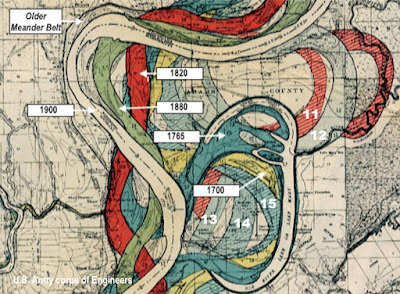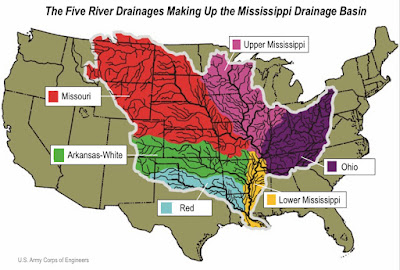When it comes to the Heartland Theory and the model of the Mississippi River being the Sidon River of the Book of Mormon, neither of these two factors are met. As an example:
1. The Sidon River mentioned
throughout the Nephite record was a river that had its head, or the source of
the river, in the highlands or mountains south of the Land of Zarahemla, within
the Narrow Strip of Wilderness that separated the Land of Zarahemla on the
north from the Land of Nephi on the south (Alma 22:27; 2:15).
2. The Sidon River was at a higher elevation than the Land of Zarahemla, making the Narrow Strip of Wilderness at a higher elevation and the Land of Nephi south of there at a higher elevation than the Land of Zarahemla. This is attested to by two facts: 1) The source or head of the river was in this area, and would have required an elevation higher than the land of Zarahemla in order to flow “by the land of Zarahemla” (Alma 2:15); and 2) It is continually mentioned that the Lamanites “went down” to the Land of Zarahemla from their Land of Nephi, and that the Nephites “went up” to the Land of Nephi from their Land of Zarahemla.
Thus, the Sidon River flowed from south (higher elevation) to north (lower elevation). And the Land of Nephi, Narrow Strip of Wilderness, and the head of the Sidon River was at a much higher elevation that that of the Land of Zarahemla.
To compare that with the Mississippi River, which runs from north to south, and the around the Mississippi River, throughout its length, are basically flat lands, with higher level bluffs along its banks, making the Mississippi River inconsistent with the Sidon River and not interchangeable land forms.
To stress this, what we know from the scriptural record is that the Mississippi did not basically run east and west, as is shown in numerous statements indicating it had “east banks” (Alma 2:15, 2:17, 6:7, 16:7, 43:53, 39:16); and also had “west banks” (Alma 8:3, 43:27, 43:32, 43;53). Not only is there no mention of north or south banks, a river running north and south would not have north and south banks.
Now, despite the fact that the head
of the river is south of Zarahemla and runs past the east borders of the land
of Zarahemla, which is a land that runs east and west, “from the east to the
West Sea,” Heartland theorists, such as Rod L. Meldrum, has specifically said:
“Rivers often make significant changes in direction over short stretches as
they wind around geographic obstacles. One should not assume the River Sidon,
or any lengthy natural river, would run exclusively in exactly one direction”
(Meldrum, “The Mississippi: Could it have been River Sidon?” Book of Mormon Evidence, June 4, 2010).
This is a surprising comment, since Meldrum’s river Sidon is claimed to be the Mississippi River, which American river runs predominantly north to south for 2,300 miles, from Minnesota to the Gulf of Mexico. While twists and turns exist throughout its long course, there is no question looking at it on a map, that the river predominantly runs north to south. In addition, the Nile River in Egypt runs predominantly south to north for 4,258; the Yenisei River in China, runs predominantly south to north for 3,441 miles, and the Amazon in South America runs predominantly west to east for 3,976 miles, making three of the four longest rivers in the world run predominantly in one direction. Thus, Meldrum’s argument is faulty and completely without merit.
However, the alluvial plains along
the Mississippi River, is not the only matter. When it comes to the difference
in elevation of the Book of Mormon lands surrounding the Sidon River from its
course “running by the land of Zarahemla” to its “head” in the Narrow Strip of
Wilderness, showing specific differences in land form and elevation, we do not
find anything like that along the Mississippi. In fact, from its entire length,
the river runs through one general open plain, stretching from the eastern foot
of the Rocky Mountains to the Mississippi River, then 760 miles eastward to the
system of mountains known as the Appalachians in which begin in
eastern Pennsylvania and travel southward for 1500 miles to around the northern
borders of Alabama and Georgia.
The approximate mean elevation, according to the U.S. Geological Survey, of the ten states along the Mississippi River along the West Bank are:
Minnesota 1200
Iowa 1100
Missouri 800
Arkansas 650
Along the East Bank are:
Wisconsin 105
Illinois 600
Tennessee 900
Kentucky 750
Louisiana 100
Adjacent to these states to the east are:
Michigan 900
Indiana 700
Ohio 850
Mississippi 300
Alabama 500
Further east are the states of:
New York 1000
Pennsylvania 1100
North Carolina 700
South Carolina 350
Georgia 600
The point should be obvious that
when Mormon describes a land that is considerably higher in elevation, saying “the
Lamanites will cross the river Sidon in the south wilderness, away up beyond the borders of the land
of Manti” (Alma 16:6), with Nephites going up to the Land of Nephi, and
Lamaniates going down to the Land of Zarahemla, such would not be possible
along the Mississippi for several 690 miles to the west and 750 miles to the
east. There is simply no way that Meldrum, or other Heartland theorists, can
claim that the Mississippi River is the Sidon River.
This is where theorists go wrong—they start out believing that Zarahemla, Iowa, is the Zarahemla of the scriptural record and go to great lengths to quote from tee D&C about the Lord telling Joseph Smith to name that area by that name, then take the giant leap to believing that ergo that area must be the original Zarahemla. Then they look around for other means described in the land of Zarahemla, with the Mississippi their obvious candidate for the Sidon River, which makes a lot of sense to them.
However, the fact is that neither Zarahemla, Iowa, nor the Mississippi River match the descriptions and land arrangement described in the Book of Mormon, as any search of the land and its terrain, as well as its history, would obviously show it was not compatible with Mormon’s descriptions. But still, they go with their interest rather than the scriptural record. And in that, they err.
2. The Sidon River was at a higher elevation than the Land of Zarahemla, making the Narrow Strip of Wilderness at a higher elevation and the Land of Nephi south of there at a higher elevation than the Land of Zarahemla. This is attested to by two facts: 1) The source or head of the river was in this area, and would have required an elevation higher than the land of Zarahemla in order to flow “by the land of Zarahemla” (Alma 2:15); and 2) It is continually mentioned that the Lamanites “went down” to the Land of Zarahemla from their Land of Nephi, and that the Nephites “went up” to the Land of Nephi from their Land of Zarahemla.
Thus, the Sidon River flowed from south (higher elevation) to north (lower elevation). And the Land of Nephi, Narrow Strip of Wilderness, and the head of the Sidon River was at a much higher elevation that that of the Land of Zarahemla.
To compare that with the Mississippi River, which runs from north to south, and the around the Mississippi River, throughout its length, are basically flat lands, with higher level bluffs along its banks, making the Mississippi River inconsistent with the Sidon River and not interchangeable land forms.
To stress this, what we know from the scriptural record is that the Mississippi did not basically run east and west, as is shown in numerous statements indicating it had “east banks” (Alma 2:15, 2:17, 6:7, 16:7, 43:53, 39:16); and also had “west banks” (Alma 8:3, 43:27, 43:32, 43;53). Not only is there no mention of north or south banks, a river running north and south would not have north and south banks.
The
Mississippi River runs basically and predominantly north to south, here shown
passing one of the many bluffs along its bank
This is a surprising comment, since Meldrum’s river Sidon is claimed to be the Mississippi River, which American river runs predominantly north to south for 2,300 miles, from Minnesota to the Gulf of Mexico. While twists and turns exist throughout its long course, there is no question looking at it on a map, that the river predominantly runs north to south. In addition, the Nile River in Egypt runs predominantly south to north for 4,258; the Yenisei River in China, runs predominantly south to north for 3,441 miles, and the Amazon in South America runs predominantly west to east for 3,976 miles, making three of the four longest rivers in the world run predominantly in one direction. Thus, Meldrum’s argument is faulty and completely without merit.
The plains of the lands between the Rocky Mountains and the Appalachian
and far eastern mountains. Between the Great and Central plains, the various
plains throughout the Midwest and central states, the land form is basically
one of flat land with some low-lying and rolling hills
The approximate mean elevation, according to the U.S. Geological Survey, of the ten states along the Mississippi River along the West Bank are:
Minnesota 1200
Iowa 1100
Missouri 800
Arkansas 650
Along the East Bank are:
Wisconsin 105
Illinois 600
Tennessee 900
Kentucky 750
Louisiana 100
Adjacent to these states to the east are:
Michigan 900
Indiana 700
Ohio 850
Mississippi 300
Alabama 500
Further east are the states of:
New York 1000
Pennsylvania 1100
North Carolina 700
South Carolina 350
Georgia 600
In
this part of the Midwest and Central United States, where the Mississippi flows,
the land is predominantly flat, from state to state to state. Certainly there
is no area anywhere close to the Mississippi River that equates to the elevated
Land of Nephi or the elevation of the Narrow Strip of Wilderness from where the
Sidon River flows downward
This is where theorists go wrong—they start out believing that Zarahemla, Iowa, is the Zarahemla of the scriptural record and go to great lengths to quote from tee D&C about the Lord telling Joseph Smith to name that area by that name, then take the giant leap to believing that ergo that area must be the original Zarahemla. Then they look around for other means described in the land of Zarahemla, with the Mississippi their obvious candidate for the Sidon River, which makes a lot of sense to them.
However, the fact is that neither Zarahemla, Iowa, nor the Mississippi River match the descriptions and land arrangement described in the Book of Mormon, as any search of the land and its terrain, as well as its history, would obviously show it was not compatible with Mormon’s descriptions. But still, they go with their interest rather than the scriptural record. And in that, they err.































